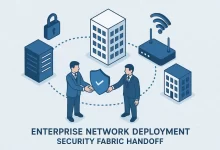3 Articles
Tags :IT Security

Enterprise Network Deployment isn’t truly “done” when the links come up—it’s secure when every hostile packet dies at the perimeter and inside the fabric. After hammering through discovery, architecture, and implementation in Parts 1-3, our outsourced MSP crew now shoulders the heaviest crown: building a security posture that survives auditors, red-team drills, and next month’s zero-day headline. Why Zero-Trust Is Non-Negotiable for Outsourced Deployments When a giant enterprise hires us instead of leaning on its own IT squad, it’s betting that we’ll spot and squash threats faster than an in-house team juggling ten other projects. Zero-trust gives us that edge because identity becomes the new perimeter—users, devices, and apps must prove themselves at every hop. Think of it as...

If you told my younger self that the Microsoft Defender icon—once mocked as the “paper shield”—would someday guard terabytes of client data on my RAID array, I’d have laughed. Yet here we are: Windows’ built-in security stack grabs perfect scores at AV-TEST, rolls out cloud-AI signatures faster than some vendors ship hotfixes, and costs exactly zero bucks. This deep-dive unpacks its core modules, pro tweaks, and lesser-known enterprise muscles so you can quit juggling clunky third-party suites. Quick note: Everything below follows the same chapter order Microsoft uses inside Windows Security, so feel free to jump to the bits you need. The feature list mirrors the original technical brief I translated last week—straight from a Mandarin PDF that listed every...

As an IT professional, one of the constant challenges I face is managing suspicious files and spam emails within our company. Often, these emails or attachments might look legitimate but could easily contain hidden malware that could put our network and data at risk. That’s where Windows Sandbox comes into play—a simple yet powerful solution I rely on daily. Why Choose Windows Sandbox? Windows Sandbox is essentially a lightweight, isolated desktop environment, perfect for safely testing files and links without risking your main operating system or network. Once you close the Sandbox, everything inside it is permanently deleted, making it ideal for handling uncertain files. My Step-by-Step Approach to Testing Files in Windows Sandbox 1. Enabling Windows Sandbox First things...


 FoxDoo Technology
FoxDoo Technology FoxDoo Technology
FoxDoo Technology
